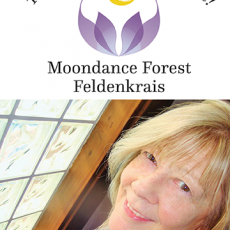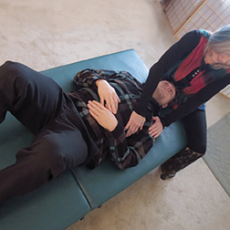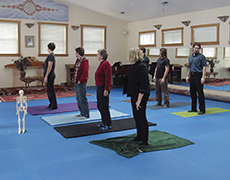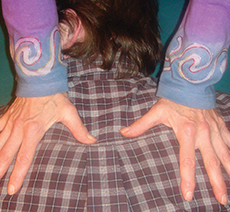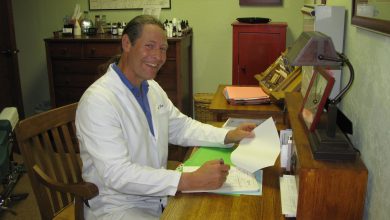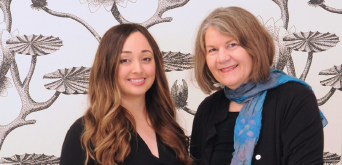Repatterning For Your Brain and Body
In this interview, local Feldenkrais practitioner Moondance Forest, M.Ed. talks to us about the Feldenkrais Method® and how it can bring a sense of grace in movement and a sense of wellbeing as we advance in age.
Moondance, thanks so much for speaking with us today. Please tell about your background and how you became involved with the Feldenkrais Method®.
I was intrigued right away when I was introduced to the Feldenkrais Method®. My first exposure was in 1994 in an undergraduate course in dance and movement at Cleveland State University. The professor began the class by saying, “Lie down on your back, close your eyes, begin to be aware of your contact with the floor, there is nothing to correct, just notice.” I immediately felt comfortable, as she continued, “Use the least amount of effort to do each action, there is nowhere to go, no one to impress, do not compare yourself to your neighbor, or have any ambition to achieve, just pay attention to your breath, your eyes, your tongue.” This led to my overall feeling of satisfaction and ease. By the end of class, I couldn’t wait until the next one.
I have always been a kinesthetic learner, experiencing life through physical activities and looking for the perfect regime for health and longevity, a natural way to feel balanced, confident, and at ease in the environment. In this pursuit, I have experienced ‘hitting the wall’ in sports, feeling creative and artistic through dance, ‘slowing down and feeling the inner and outer’ in Tai Chi and Qigong, ‘strengthening my core’ in Super Slow weight training and Pilates, and ‘unifying the mind and body through breath’ in yoga. And yet, I didn’t really feel a deep sense of comfort and satisfaction with myself until I experienced the Feldenkrais Method®. Although I believe we never stop learning and my body education continues, this method of awareness through movement has been transformational in my journey. After receiving my BA, I wanted to teach, so I continued my studies of bodies in motion by getting my Masters of Education in Exercise Physiology and Sports Medicine and began teaching college courses in fitness, running, swimming, skiing, boating, tai chi, qigong, yoga and many more.
In order to diversify my knowledge of the body and to be able to work with people one-on-one, I got my massage license. While working as a massage therapist deepened my understanding of anatomy and physical treatment, it also revealed the limitations of structural therapy. I became more and more interested in functional integration and somatic education, realizing how these approaches could offer more and longer lasting benefits. Additionally, I wanted to reconnect with my work as an educator, working with students rather than treating clients. In this way, Feldenkrais provides an opportunity to combine my training and experience in exercise and health with my pedagogical work. I feel uniquely qualified to be a movement educator and excited to share my knowledge and experience with others.
What are some of the core concepts in the Feldenkrais Method®?
Our awareness or education about the human body, our home for our entire lives, is incomplete, to say the least. One of the most thoroughly neglected areas is the dialogue between inner and outer experience in relation to the whole person. We are very familiar with outer perceptions, experiencing the body through the sense organs of sight, sound, taste, smell, and touch. However, our capacities for inner sensing, using our nervous system to monitor the inner states of the body, are far less developed. The experience of pain can be a crucial aspect of this system of communication and sense. By disregarding pain, we are continuing to limit our understanding or awareness of the body.
The Feldenkrais Method® is all about becoming fully aware of the way we move or use our bodies. The basic goal of the practice is to take notice of our habits and automatic or unconscious movements. This newfound awareness can help you identify inefficient or awkward aspects of your habitual movement and transform you into a more active participant in your own body’s movements.
People might think that their problems are caused by not being strong enough or by being damaged, when actually it is a result of how they are moving. They assume that if you are weak, then you should exercise to strengthen your muscles or if you think bad posture causes your problem, then you should correct it and stand up straight. Both assume the body is something that must be molded, reshaped, put in its proper place. Neither approach gives you the chance to see that what you are ‘doing’ might contribute to the problem you face. Neither approach looks at how you move and how that could relate to what you are experiencing.
Because our movements are often habitual or automatic, we repeat the same movements over and over, without thinking or noticing. When something happens repeatedly, it drops from our consciousness. This isn’t necessarily bad, it is a part of the process of learning. Most of us don’t think about our bodies until we experience pain or some kind of problem. But that means that we could have been moving in an inefficient or dangerous way for a long time before we notice something is wrong. Since we don’t really understand how our bodies move, we often move in ways that don’t fit with the way we are put together. For example, sometimes people think that the body hinges at the waist and they move as if that were so. Unfortunately, the lower back does not allow for that kind of motion; the design of hip joints is what allows the torso to bend forward and back. Interestingly enough, this is the region where many people have pain or limitations in movement.
Feldenkrais teachers typically avoid giving formulas for ‘proper’ or ‘correct’ ways of moving. Instead, we strive to create safe conditions that lead students to self-discovery. Therefore there are no models to imitate, no mirrors, and very few rights and wrongs. We encourage slowing down, reducing effort, and we direct students’ attention internally. Awareness is the potential to make shifts of attention, to bring from the background to the fore the relevant features, to find new combinations and patterns and therefore new meaning. With this internal clarity, reorganizing happens spontaneously. This type of learning resembles the process that we engaged in during the early stages of development, when we were learning to roll from side to side, crawl, stand and walk. Awareness has the ability to broaden and deepen our lives.
Rather than ‘fixing’ the body, Dr. Moshe Feldenkrais taught how to expand its capacities and ranges of choice. He said, “I am going to be your last teacher. Not because I’ll be the greatest teacher you may ever encounter, but because of me you will learn how to learn. When you learn how to learn, you will realize that there are no teachers, that there are only people learning how to facilitate learning.”
A large part of your work is paying attention to how your clients move and helping them to resolve and discover new opportunities of movement.
I begin by seeing how the client moves, asking them to turn right and left, bend forward, back and to each side. I put my hands on them to feel which muscles are working, which muscles aren’t engaging, and which ones aren’t letting go. As I do this, I’m looking for the habit or pattern that interferes with other movements. Then, working together, we discover ways for them to move with more grace and ease.
What are some of the benefits of Feldenkrais?
The spaciousness of the gentle innovative lessons allows you to observe how you move, notice unnecessary tension, and improve overall coordination and balance. Some of the benefits most often reported are:
-Relief from chronic pain and discomfort
-Improved posture, balance and stability
-Aid in recovery from injury or stroke
-Increased energy and stamina
-Better sleep patterns
-Increased physical and mental performance
-Reduced stress and fatigue
-Improved ability to concentrate
-Ease of movement in everyday activities
-An overall sense of wellbeing
Can you tell us a few specific success stories?
Sure, here are a few examples of people who were helped through Feldenkrais:
-A 42-year-old computer programmer with wrist problems was able to increase his speed on the keyboard after learning how to use his arms and hands more efficiently.
-A 78-year-old man was able to walk a mile daily, free of chronic knee pain he had for 30 years.
-A 32-year-old man learned to use his hands again after a crippling auto accident.
-A 55-year-old woman is able to lift her affectionate young granddaughter without straining her back.
-A 9-year-old with learning disabilities could read a full page competently and gained self-confidence and intelligence.
-A 40-year-old cellist developed new, less strained positions to play and extended her musical repertoire.
You mentioned that Feldenkrais helps you age gracefully – tell us how that works.
We are all born with built-in wisdom. Our bodies and nervous systems have wisdom in how to move with grace and ease. Depending on your age or life experiences, this innate wisdom may be hiding under a few layers of habit (or injury, trauma, routine, etc.), or it may be hidden under a landslide. The great thing about the human system is that even if you don’t cultivate this innate bodily wisdom regularly or have never been one to seek modes of becoming more in tune with yourself, your nervous system and brain are always there, waiting to be stimulated. Our natural capacity to learn remains. So how do you find it again?
This is where the Feldenkrais Method comes in. Through techniques like Awareness Through Movement classes and Functional Integration sessions, you can reinvigorate your latent capacity for pain-free and tension-free movement. You can rediscover how to distribute the work and effort of movement throughout your body, finding new ways to both move and to relax. With this new-found awareness, the process of aging becomes less about mitigating injury or living with limitations and more about reconnecting with your body’s wisdom. It is not about overcoming your body’s decline, but seeing aging as an opportunity to relearn how to move.
In the Feldenkrais Method® each person already presents the ideal body, the ideal way to move. For many this is a difficult concept to grasp, especially when we think about aging. Usually we take pain, ‘poor’ posture, or limited movement as symptoms of something wrong. Yet each and every person makes the best choices possible given his or her perception of choices. Change is most possible in this realm of ‘perception of choices.’ My task as teacher/practitioner is to create conditions for more choices. It is not to correct errors, right wrongs, or straighten people out. For me, aging doesn’t limit us, but merely changes our perception of our choices.
As Dr. Moshe Feldenkrais said, “Through awareness we can learn to move with astonishing lightness and freedom – at almost any age – and thereby improve our living circumstances, not only physically…but emotionally, intellectually and spiritually.”
I love the definition of health you shared with me that describes the resilience of the body and brain.
Yes, I have been inspired by the way Moshe Feldenkrais defined health in terms of resilience. He wrote: “Health is the capacity to recover from shock, the ability to overcome obstacles, the capacity to live one’s dreams.” We all go through the process of recovery, continually responding to life’s traumas, big and small.
Our bodies and brains have an incredible capacity for healing and resilience. The term neuroplasticity names this phenomenon and has recently been explored by best-selling author Norman Doidge M.D. in his book, The Brain’s Way of Healing. As authors like Doidge point out, the brain can recover from injury or trauma by relearning innate patterns and functions. He feels that Moshe Feldenkrais was a pioneer in recognizing the plasticity of the brain and developing methods for harnessing its benefits. This new approach to health and longevity works with the brain’s innate capacities and shows how they can be utilized without the intervention of the medical establishment.
———————
Moondance carefully guides students through seemly simple movements that result in a new feeling of strength and flexibility. I’m looking forward to more classes.
-Susan Reid, Ashland
————
How do you work with your clients?
I offer two distinct ways for students to engage with the Feldenkrais Method®.
One of these is in group classes, called Awareness Through Movement. These courses are open to the public and take place in an open room with students laying on mats or sitting in chairs. In these classes, I verbally guide students through a sequence of movements in basic positions: sitting or lying on the floor, standing or sitting in a chair. We work through novel or unusual movements meant to bring you to new types of awareness about your habitual movements. There are more than 2,000 distinct Feldenkrais lessons to work with, most of which explore everyday actions such as reaching, getting up from a chair, turning, bending and walking. Many are simple to perform, and were especially designed for people for whom movement is a challenge.
I also offer private Feldenkrais lessons, called Functional Integration in my studio in downtown Ashland. These lessons are tailored to each student’s individual needs. Feldenkrais Functional Integration® is hands-on developmental movement, done clothed on a massage-type table. The lessons are approximately 45 minutes. Sessions are deeply relaxing, easy, gentle, and comfortable.
———————
“I have referred many patients to Moondance over the years and they all have benefited tremendously from her treatments” –Kris Kokay L.Ac.
————
What are the next steps for someone who wants to learn more or to work with you?
It is difficult to explain Feldenkrais in words — it’s much more revelatory to experience it. I offer a free introductory class in my weekly Awareness Through Movement classes for all first-time students. Private, Functional Integration sessions are available by appointment.
People can find out more on my website at moondanceforest.net where they will see a video of the Feldenkrais Method® in action. I encourage people to join my mailing list to be notified of classes and special offers. Or just call me at 541-936-7274. I’d love to talk to you!
Learn More:
Moondance Forest, M.Ed.; GCFP
541-936-7274
Check out her website here

